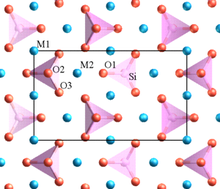- Monticellite
-
Monticellite-Kirschsteinite General Category Nesosilicate Chemical formula Ca(Mg,Fe)SiO4 Strunz classification 09.AC.10 Identification Color colourless or grey Crystal system Orthorhombic Cleavage {010} Mohs scale hardness 5.5 Specific gravity 3.05 – 3.27 Refractive index α = 1.638 – 1.654,
β = 1.646 – 1.664,
γ = 1.650 – 1.674Monticellite and kirschsteinite are gray silicate minerals of the olivine group with compositions CaMgSiO4 and CaFeSiO4, respectively. Most monticellites have the pure magnesium end-member composition but rare ferroan monticellites and magnesio-kirschsteinite are found with between 30 and 75 mol.% of the iron end member. Pure kirschsteinite is only found in synthetic systems. Monticellite is named after Teodoro Monticelli Italian mineralogist (1759–1845).
Like other members of the group monticellite and kirschsteinite have orthorhombic unit cells (space group Pbnm) shown in Figure 1. Iron and magnesium ions are located on the M1 inversion sites and calcium ions occupy the M2 site on mirror planes. The unit cell is somewhat larger than for the calcium free olivines forsterite and fayalite with
- a = 0.4815 nm,
- b = 1.108 nm and
- c = 0.637 nm,
and for monticellite
- a = 0.4875 nm,
- b = 1.1155 nm and
- c = 0.6438 nm.
References
- Deer, W. A., Howie, R. A., and Zussman, J. (1992). An introduction to the rock-forming minerals (2nd ed.). Harlow: Longman ISBN 0-582-30094-0
- Mindat.org
- Webmineral.com
- Handbook of Mineralogy

This article about a specific silicate mineral is a stub. You can help Wikipedia by expanding it.

